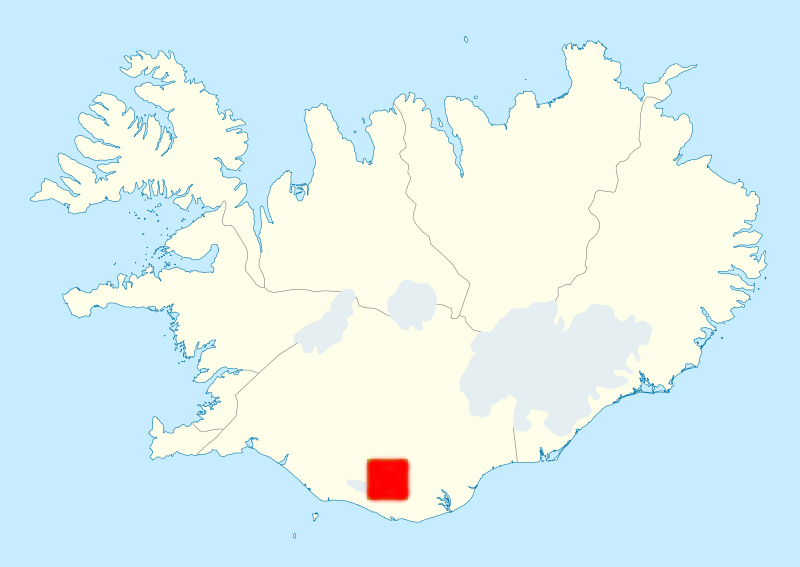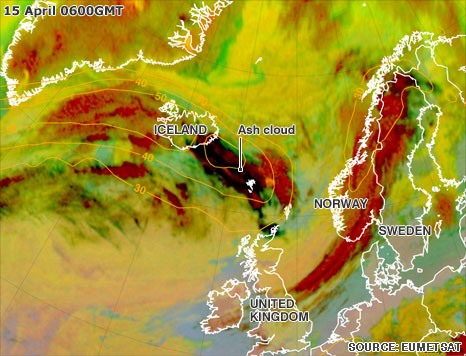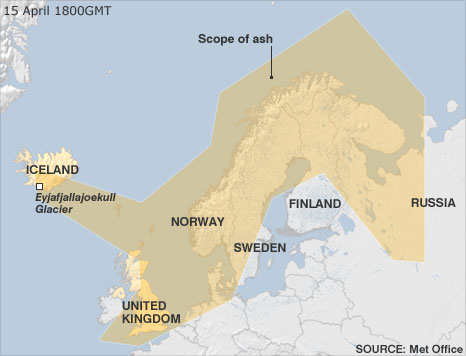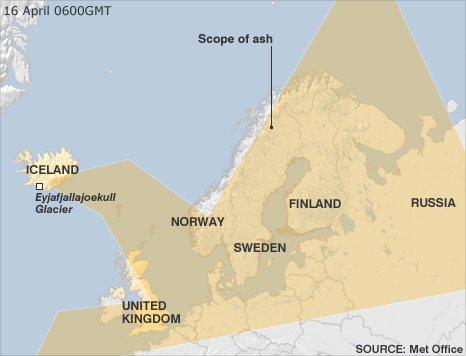The Icelandic glacier of Eyjafjallajökull (“island mountain glacier”) covers a 1,666 m high volcano which has erupted twice this year (on March 20 and April 15). The April 15 eruption resulted in major flooding and the evacuation of 800 people, a massive plume of volcanic ash which has caused severe disruption of air traffic across Northern Europe, and fears that its seismic activity may trigger a second eruption at the nearby and much larger subglacial volcano of Katla.
According to the BBC News, “The volcano beneath the Eyjafjallajoekull glacier began erupting on Wednesday for the second time in a month, hurling a plume of ash 11km (seven miles) into the atmosphere. By the time it reached the northern UK, it had risen to 16km. Up to 5,000 flights could have been affected by the end of Thursday. Planes have been grounded in the UK, Ireland, the Netherlands, Belgium, Denmark, Norway, Sweden and Finland. France is also preparing to close its main airports. The UK closed its entire airspace to all but emergency flights because of the risk of the ash damaging planes’ engines. The restrictions are not expected to be lifted before 0700 (0600 GMT) on Friday at the earliest.”
Iceland is located on the Mid-Atlantic Ridge, the unstable boundary between the Eurasian and North American continental plates, and it has about 130 volcanic mountains, 18 of which have erupted since the 9th century. “Over the past 500 years, Iceland’s volcanoes have erupted a third of the total global lava output. Although the Laki eruption in 1783 had the largest eruption of lava in the last 500 years, the Eldgjá eruption of 934 AD and other Holocene eruptions were even larger. Geologists explain this high concentration of volcanic activity as being due to a combination of the island’s position on the Mid-Atlantic Ridge and a volcanic hotspot underneath the island. The island sits astride the boundary between the Eurasian and North American Plates, and most volcanic activity is concentrated along the plate boundary, which runs across the island from the south-west to the north-east of the island. Some volcanic activity occurs offshore, especially off the southern coast. This includes wholly submerged submarine volcanoes and even newly formed volcanic islands such as Surtsey and Jólnir” (Wikipedia).
“Over the past 1,100 years, Eyjafjallajökull has erupted four times: in 920, 1612, between 1821–1823, and in 2010. Each of the first three of these incidents directly preceded a major eruption in the nearby subglacial volcano, Katla. There is so far no evidence that Katla will erupt because of its vicinity to the current eruption in Eyjafjallajökull. Katla, which is a much more active volcano, known for its powerful subglacial eruptions and its large magma chamber, much larger than that of the Eyjafjallajökull volcano system, has still not shown any unusual activity, like expansion of the crust or seismic activity. However, one cannot rule out that possibility, since history has shown that Eyjafjallajökull can be a precursor to additional Katla activity. Some geophysicists in Iceland support the notion that the recent volcanic eruption at Eyjafjallajökull may trigger a second eruption at Katla, which would cause a major flooding event due to melting of glacial ice” (Wikipedia).





